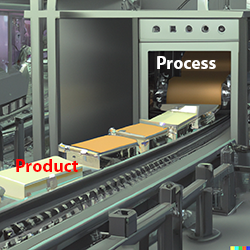Nov 22 2022
Processes and Products | Cécile Roche
This is the perspective of Cécile Roche about what we saw in the Van-of-Nerds tour in September, 2022:
The risk when we talk about digital, even more than when we talk about Lean, is to worry about processes before worrying about products. We must never forget that a process is never an end in itself. It is at the service of creating value for customers — in other words, products — and at the service of improving people’s working conditions — making the work easier and improving its quality. Lean practices are not implemented to produce faster. They are implemented to reveal problems as soon as possible, in order to take care of the customers by taking care of the products, and for that, make people grow in autonomy by developing their capacity for problem solving and then increase productivity through quality.
Contents
Support of Kaizen, or the End of Kaizen?
Digitalization leads above all to the automation of the most repetitive activities, in order to make people’s lives easier and to free up time for the improvement and handling of unexpected situations, such as changes of context, daily problems, unavoidable difficulties, etc.
When interest in processes and tools takes precedence over interest in product and people — that is, when process and tools become a goal in themselves, people are quickly disempowered and expect systems to answer their questions and solve their problems. This is the end of Kaizen… The great principle of Lean, which is to separate the work of the human from that of the machine, and to ensure that the machines are at the service of the human, and not the other way round, is forgotten. This is where you hear phrases like “It’s impossible, the ERP doesn’t allow it” or “We should have to reprogram the system, but that takes too much time”. The worst case is when you don’t even think about it anymore… the boss is the system!
Falling in Love with the System
We observed in some of the factories we visited a tendency to “fall in love with the system”, to focus on procedures at the expense of the product. Digital technology can accentuate this effect, and the fascination with automatic indicators and colour graphics often hides late products, non-quality, unresolved problems…
Generally speaking, problem detection works quite well, but real-time problem solving, with the elimination of root causes, is more elusive or far too delayed in time to be effective. And Kaizen – which goes beyond problem solving to improve work practices under the leadership of the people doing the work – is even rarer. However, where it exists, progress is significant, as is the involvement of people.
CONWIP Example
As an example of this drift, this screen represents the digitisation of a CONWIP (constant Work In Progress) tool:
Each stage of the process has a column, with a maximum admissible level of parts in the flow. The corresponding boxes are color-coded, and by reading the legend, we realize that the purple boxes are “old delay”. Not to mention the fact that the qualification “old delay” is not very accurate, we are told that the workload is currently low, and that it is better to leave components “in the pipe” than to risk leaving people unoccupied. Moreover, the reprogramming of the CONWIP is complicated, and the situation will “return to normal” in a while.
And finally, if one pushes the curiosity and looks at the reality on the Gemba and not the screen — that is, the products in process at this place, we observe that the WIP is higher than the limit proposed by the CONWIP… This means that the digital CONWIP system does not work at all. Moreover, the objective of visual management, which is to remove as much ambiguity as possible in the work, because it is a source of defects, and to give people the opportunity to learn and solve problems, is here completely diverted. This screen is in fact adding ambiguity.
Screen Overload Example
The other example has been noted several times. It is when, in the enthusiasm of the power of digital, a lot of information is added to screens, even if it means having to click on multiple windows opening other windows to find the information… which makes it inaccessible to all but the managers, as people have neither the time nor the skills to spend their time in front of a screen looking for what should be jumping out at them to help them in their work.
Conclusion
Digital technology brings computing power and easy access to data; this must remain at the service of people, facilitating their work and their ability to think about their jobs.


The Van of Nerds in France—Overview and Aircrafts | AllAboutLean.com
December 4, 2022 @ 11:02 pm
[…] Processes and Products | Cécile Roche […]
January 15, 2023 @ 6:28 pm
Many a time people get confused about lean, digitalisation etc. In that confusion, they move in wrong direction and fail, thereby creating a wrong image about great concepts. That is why the penetration of lean and digitalisation is not to that extent where it was expected.
To avoid such a situation, we must always ask ‘ why I do what I do? What us tge ultimate purpose?’. One must constantly keep reminding oneself about this . When you keep questioning yourself regularly this, you will be able to make out whether you are on track to realise the end goal or not. If not, fo course correction and come back.This is key. The marketing people and consultants need to play a sincere role.
The Difficulties of Dazzling Digital Shop Floor Dashboards | AllAboutLean.com
January 17, 2023 @ 3:01 am
[…] Processes and Products | Cécile Roche […]